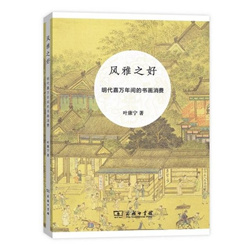Cultural consumption in the Ming Dynasty
Author : LIU DELONG Source : Chinese Social Sciences Today 2017-09-04

Favor for Elegance: Consumption of Calligraphy and Paintings in the Ming Dynasty
Author: Ye Kangning
Publisher: Commercial Press
The Riverside Scene at Qingming Festival is a masterpiece in the history of Chinese paintings. Created by Zhang Zeduan, the painting depicts the hustle and bustle of scenes along the two sides of the Bian River in Kaifeng, the capital of the Northern Song Dynasty, revealing the social environment at that time. The artwork is one of China’s most popular among the broader public.
In Favor for Elegance, author Ye Kangning discards the usual research focus on the painting, and considers the painting as a commodity to investigate the complex guanxi network and renqing behind the collection and sale of the painting from sociological and economic perspectives, revealing the economic ties among elite groups during the Jiawan years in the Ming Dynasty.
Ye divided the book into eight parts, including the “social atmosphere,” “demand,” “market review,” “antiquary,” “price” and “counterfeits.” Ye pointed out that the leisure class, mainly consisting of scholars and businessmen, were keen on sensual pleasures. Collecting calligraphy and paintings was not only a fashion trend but also a way to discriminate between the elegant and the vulgar. In the book, Ye recounts a series of historical incidents focusing on a disturbance on the Riverside Scene at Qingming Festival that were linked by key plot points with succinct titles as summaries, such as “Wangshu seeking the painting,” “Huangbiao making a counterfeit,” “Tangchen asking for bribes,” and “Yan’s Murder.” Through these stories, Ye investigates the relationship between the consumer, consumer demand and the consumer environment, and how these are affected by changes in the price of calligraphy and paintings. In particular, Ye gives reasons for the existence of counterfeit works.
Calligraphy and paintings are considered elegant works that are free from vulgarity. They are used as both an indicator of economic strength and a symbol of superior cultural taste. Therefore, collecting paintings and calligraphy is a shortcut by which the nouveau riche to attain respect and honor. Though paintings are not vulgar things, they could be used for vulgar purposes. Calligraphy and paintings are worth a lot but weigh little, which made them an ideal form of bribe. This is also largely because the opacity of the paintings’ prices ensured their security. Thus sending and accepting paintings were safer than communication in gold and silver.
Violations of economic laws occur at times in the trading of calligraphy and paintings, sometimes for political ends. Wang Shu bought a counterfeit copy of the Riverside Scene at the Qingming Festival for 1,200 pieces of gold to please the man in power, much higher than the market price. But given Wang’s political purposes, the money he paid was reasonable. The consumption of calligraphy and paintings is conspicuous and occasional, resulting in price obscurity and uncertainty.
Ye also listed the trading prices of calligraphy and paintings in the years of 1522-1619. Ancient scholars were ashamed to discuss prices. Xiang Yuanbian, a connoisseur in the Ming Dynasty, liked to record the prices of the calligraphy and paintings he collected, and hence took some stick. Due to this atmosphere, information about prices of the time can only be found in notes and essays.
Ye Shengtao made Chinese fairy tales from a wilderness
Ye Shengtao (1894–1988) created the first collection of fairy tales in the history of Chinese children’s literature...
-
How northern ethnicities integrated into Chinese nation
2023-09-18
-
Mogao caves
2023-09-12
-
Mogao Grottoes as ‘a place of pilgrimage’
2023-09-12
-
Time-honored architectural traditions in China
2023-08-29
-
Disentangling the civilizational evolution of China
2023-08-28
-
AI ethics in science fiction
2023-08-23














 2011-2013 by www.cssn.cn. All Rights Reserved
2011-2013 by www.cssn.cn. All Rights Reserved